《化工热力学》课程教学课件(英文讲稿)溶液热力学原理 Solution thermodynamics:Theory
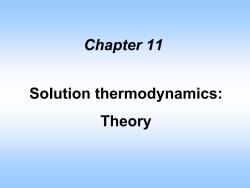
Chapter 11 Solution thermodynamics: Theory
Chapter 11 Solution thermodynamics: Theory
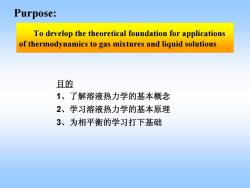
Purpose: To develop the theoretical foundation for applications of thermodynamics to gas mixtures and liquid solutions 且的 1、了解溶液热力学的基本概念 2、学习溶液热力学的基本原理 3、为相平衡的学习打下基础
Purpose: To develop the theoretical foundation for applications of thermodynamics to gas mixtures and liquid solutions 目的 1、了解溶液热力学的基本概念 2、学习溶液热力学的基本原理 3、为相平衡的学习打下基础
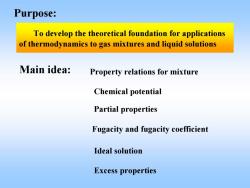
Purpose: To develop the theoretical foundation for applications of thermodynamics to gas mixtures and liquid solutions Main idea: Property relations for mixture Chemical potential Partial properties Fugacity and fugacity coefficient Ideal solution Excess properties
Purpose: To develop the theoretical foundation for applications of thermodynamics to gas mixtures and liquid solutions Main idea: Property relations for mixture Fugacity and fugacity coefficient Partial properties Chemical potential Ideal solution Excess properties
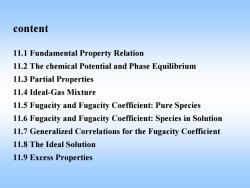
content 11.1 Fundamental Property Relation 11.2 The chemical Potential and Phase Equilibrium 11.3 Partial Properties 11.4 Ideal-Gas Mixture 11.5 Fugacity and Fugacity Coefficient:Pure Species 11.6 Fugacity and Fugacity Coefficient:Species in Solution 11.7 Generalized Correlations for the Fugacity Coefficient 11.8 The Ideal Solution 11.9 Excess Properties
content 11.1 Fundamental Property Relation 11.2 The chemical Potential and Phase Equilibrium 11.3 Partial Properties 11.4 Ideal-Gas Mixture 11.5 Fugacity and Fugacity Coefficient: Pure Species 11.6 Fugacity and Fugacity Coefficient: Species in Solution 11.7 Generalized Correlations for the Fugacity Coefficient 11.8 The Ideal Solution 11.9 Excess Properties

11.1 Fundamental Property Relation REVIEW Fundamental Property Relations of Thermodynamics for Homogeneous Phase System For one mol For n mol dU TdS-Pdv d(nU)=Td(nS)-Pd(nv) (nG) dH TdS+Vap d(nH)=Td(nS)+(nV)d(nP) OP dA=-Pdv-SdT d(nA)=-Pd(nV)-(nS)d(nT) anG) P n =-nS dG =Vdp-SdT d(nG)=(nV)dp-(nS)dT 四个微分方程式,是我们常用到的微分方程, 使用这些方程时一定要注意以下几,点: 1.恒组分、恒质量体系,也就是封闭体系; 2.均相体系(单相); 3.平衡态间的变化; 4.常用于1摩尔时的性质
11.1 Fundamental Property Relation REVIEW Fundamental Property Relations of Thermodynamics for Homogeneous Phase System dU TdS PdV dH TdS VdP dA PdV SdT dG VdP SdT = − = + =− − = − For one mol For n mol ( ) () ( ) ( ) ( ) ( )( ) ( ) ( ) ( )( ) ( )( ) () d nU Td nS Pd nV d nH Td nS nV d nP d nA Pd nV nS d nT d nG nV dP nS dT = − = + =− − = − , , ( ) [ ] ( ) [ ] T n P n nG nV P nG nS T ∂ = ∂ ∂ = − ∂
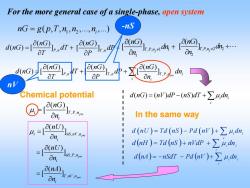
For the more general case of a single-phase,open system nG=g(p,T,h,n2,n,) -nS (nG) on, n Chemical potential dnG)=(n)dp-(nS)dT+∑4,dn (nG)1 On In the same way 4=en0) nS.nv.nja d(nU)=Td(nS)-Pd(nv)+>u,dn, -[n) d(aH)=Td(s)+ndP+∑从,dn, On; nS,P.nja d(nA)=-nSdT-Pd (nv)+udn, a(nA) on
For the more general case of a single-phase, open system 1 2 ( , , , ,., ,.) i nG g p T n n n = , , , () () () ( )[ ] [ ] [ ] P j i n T n T P n i i i nG nG nG d nG dT dP dn TP n ≠ ∂∂ ∂ = ++ ∂∂ ∂ ∑ , ( ) [ ]T n nG dP P ∂ + ∂ , 1 1 1 ( ) [ ]T Pnj nG dn n ≠ ∂ + ∂ , 2 2 2 ( ) [ ]TPnj nG dn n ≠ ∂ + ∂ d nG( )[ ] ( ) nG P n, dT L T ∂ = + ∂ , , ( ) [ ] j i i T P n i nG n μ ≠ ∂ = ∂ Chemical potential ( )( ) ( ) i i i d nG nV dP nS dT dn = −+ ∑ μ nV -nS ( ) ( ) ++= ∑i nVdPnSTdnHd μ dnii ( ) ( )+−−= ∑i nAd nVPdnSdT μ dnii ( ) ( ) ( ) i i i d nU Td nS Pd nV dn =− + ∑ μ In the same way , , , , , , ( ) [ ] ( ) [ ] ( ) [ ] j i j i j i i n S n V n i nS P n i T nV n i nU n nU n nA n μ ≠ ≠ ≠ ∂ = ∂ ∂ = ∂ ∂ = ∂
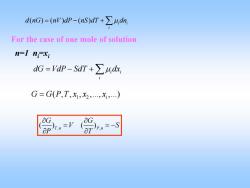
dnG)=(nWdp-(nS)dT+∑4,dn For the case of one mole of solution n-1 nxi dG=dP-SdT+∑4,a G=G(P,T,x1,x2,x,.) T )pn=-S
( )( ) ( ) i i i d nG nV dP nS dT dn = −+∑μ For the case of one mole of solution n=1 ni=xi i i i dG VdP SdT dx =−+∑μ 1 2 ( , , , ,., ,.) G GPT x x x = i , , () () T n P n G G V S P T ∂ ∂ = =− ∂ ∂
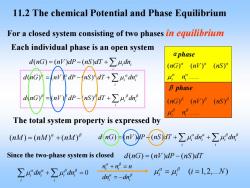
11.2 The chemical Potential and Phase Equilibrium For a closed system consisting of two phases in equilibrium Each individual phase is an open system aphase dnG)=nVdP-(nS)dT+∑4,dn (nG)"(nV) (nS) d(nG) (n水dP-ns)idr+∑4dn B phase dinG)=(nv) dP-ns)月dr+∑h,dn (nG)(nV)8 (nS) The total system property is expressed by (nM)=(nM)+(nM) Since the two-phase system is closed d(nG)=(nV)dp-(nS)dT ∑4dr+∑Adn=0 n+no=n →42=4(i=1,2,.N) dna=-dn
11.2 The chemical Potential and Phase Equilibrium For a closed system consisting of two phases in equilibrium Each individual phase is an open system αphase β phase ( ) ( ) () . i i nG nV nS n α αα α α μ ( ) ( ) () . i i nG nV nS n β ββ β β μ ( )( ) ( ) i i i d nG nV dP nS dT dn = −+ ∑ μ ( ) ( ) () i i i d nG nV dP nS dT dn α αα α α = −+ ∑ μ ( ) ( ) () i i i d nG nV dP nS dT dn β ββ β β = −+ ∑ μ The total system property is expressed by ( )( ) ( ) nM nM nM α β = + ( )( ) ( ) ii ii i i d nG nV dP nS dT dn dn α α ββ = −+ + ∑μ μ ∑ Since the two-phase system is closed d nG nV dP nS dT ( )( ) ( ) = − 0 ii ii i i dn dn αα ββ ∑ ∑ μ μ + = i i i i nnn dn dn α β α β + = = − ( 1, 2,. ) i i i N α β μ μ = =
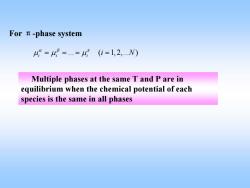
For n-phase system 4=4==4(i=1,2,N) Multiple phases at the same T and P are in equilibrium when the chemical potential of each species is the same in all phases
For π-phase system . ( 1, 2,. ) ii i i N αβ π μμ μ = == = Multiple phases at the same T and P are in equilibrium when the chemical potential of each species is the same in all phases
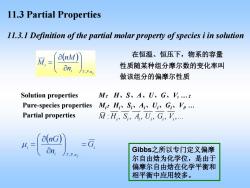
11.3 Partial Properties 11.3.1 Definition of the partial molar property of species i in solution 在恒温、恒压下,物系的容量 M, a(nM 8n, 性质随某种组分摩尔数的变化率叫 TP.n 做该组分的偏摩尔性质 Solution properties M:H、S、A、U、G、,.; Pure-species properties M:H、Si、A、U、G、V,. Partial properties M:H S,A U G,V. a(nG) 4= on, -G Gibbs.之所以专门定义偏摩 尔自由焓为化学位,是由于 偏摩尔自由焓在化学平衡和 相平衡中应用较多
11.3 Partial Properties ( ) n,P,T j i i n nM M ⎟ ⎟ ⎠ ⎞ ⎜ ⎜ ⎝ ⎛ ∂ ∂ = 11.3.1 Definition of the partial molar property of species i in solution 在恒温、恒压下,物系的容量 性质随某种组分摩尔数的变化率叫 做该组分的偏摩尔性质 ( ) i i n,P,T i G n nG j = ⎟ ⎟ ⎠ ⎞ ⎜ ⎜ ⎝ ⎛ ∂ ∂ μ = Gibbs之所以专门定义偏摩 尔自由焓为化学位,是由于 偏摩尔自由焓在化学平衡和 相平衡中应用较多。 Solution properties M : H 、 S 、 A 、 U 、 G 、V, . ; Pure-species properties Mi : Hi 、 Si 、 Ai 、 Ui 、 Gi 、 Vi, . Partial properties : , , , , , , . MH S AU GV ii i i ii
按次数下载不扣除下载券;
注册用户24小时内重复下载只扣除一次;
顺序:VIP每日次数-->可用次数-->下载券;
- 《化工热力学》课程教学课件(英文讲稿)热动力 Production of Power from Heat.pdf
- 《化工热力学》课程教学课件(英文讲稿)流体热力学性质 Thermodynamic properties of fluids.pdf
- 《化工热力学》课程教学课件(英文讲稿)纯流体性质 Volumetric Properties of Pure Fluids.pdf
- 《化工热力学》课程教学资源(作业习题)第8章 化学反应平衡(含答案).doc
- 《化工热力学》课程教学资源(作业习题)第5章 非均相体系热力学性质计算(无答案).doc
- 《化工热力学》课程教学资源(作业习题)第4章 非均相封闭体系热力学(选择题带答案).doc
- 《化工热力学》课程教学资源(作业习题)第2章 流体的P-V-T关系(含答案).doc
- 《化工热力学》课程教学资源(作业习题)第1章 绪言(无答案).doc
- 《化工热力学》课程授课教案(讲义)Chapter 13 Chemical-Reaction Equilibria.doc
- 《化工热力学》课程授课教案(讲义)Chapter 12 Solution Thermodynamics:Application.doc
- 《化工热力学》课程授课教案(讲义)Chapter 11 Solution thermodynamics - Theory.doc
- 《化工热力学》课程授课教案(讲义)Chapter 9 Refrigeration and Liquefaction.doc
- 《化工热力学》课程授课教案(讲义)Chapter 8 Production of Power from Heat.doc
- 《化工热力学》课程授课教案(讲义)Chapter 7 Application of Thermodynamics to Flow Processes.doc
- 《化工热力学》课程授课教案(讲义)Chapter 6 Thermodynamic properties of fluids.doc
- 《化工热力学》课程授课教案(讲义)Chapter 5 The Second Law of Thermodynamics.doc
- 《化工热力学》课程授课教案(讲义)Chapter 3 Volumetric Properties of Pure Fluids.doc
- 《化工热力学》课程授课教案(讲义)Chapter 2 The First Law and Other Basic Concepts.doc
- 《化工热力学》课程教学大纲 Thermodynamics of chemical engineering(新疆大学:黄雪莉).doc
- 海南大学:《精细化学品与工艺学》课程授课教案(讲义,共十章,负责人:刘钟馨、韩秀萍).docx
- 《化工热力学》课程教学课件(英文讲稿)热功转换及可用能.pdf
- 《化工热力学》课程教学课件(PPT讲稿)第一章 绪论 Chemical Engineering thermodynamics.ppt
- 《化工热力学》课程教学课件(PPT讲稿)第二章 流体的p-V-T关系.ppt
- 《化工热力学》课程教学课件(PPT讲稿)第五章 化工过程的能量分析.ppt
- 《化工热力学》课程教学课件(PPT讲稿)第七章 相平衡.ppt
- 《化工热力学》课程教学课件(PPT讲稿)第三章 流体的热力学性质.ppt
- 《化工热力学》课程教学课件(PPT讲稿)第六章 蒸汽动力循环与制冷循环.ppt
- 《化工热力学》课程教学课件(PPT讲稿)第十章 化学反应平衡.ppt
- 《化工热力学》课程教学课件(PPT讲稿)第四章 流体混合物的热力学性质.ppt
- 《化工原理》课程教学大纲 Principles of Chemical Engineering B.pdf
- 《化学反应工程》课程教学标准B.doc
- 山东理工大学:《化学反应工程》课教学大纲B.doc
- 《化工安全与环保》课程教学资源(课件讲稿)物质性质、物化原理与安全.pdf
- 《化学反应工程》课程教学资源(PPT课件)第3章 釜式及均相管式反应器.ppt
- 《化学反应工程》课程教学资源(PPT课件)第4章 反应器中的混合及对反应的影响.ppt
- 《化学反应工程》课程教学资源(PPT课件)第5章 固定床气-固相催化反应工程.ppt
- 《化学反应工程》课程教学资源(课件讲稿)第2章 气-固相催化反应本征及宏观动力学.pdf
- 《化学反应工程》课程教学资源(PPT课件)第1章 应用化学反应动力学.ppt
- 《化工安全与环保》课程教学资源(课件讲稿)第11章 化工环境保护技术.pdf
- 《化工安全与环保》课程教学资源(课件讲稿)第10章 化工厂安全操作与维护.pdf
